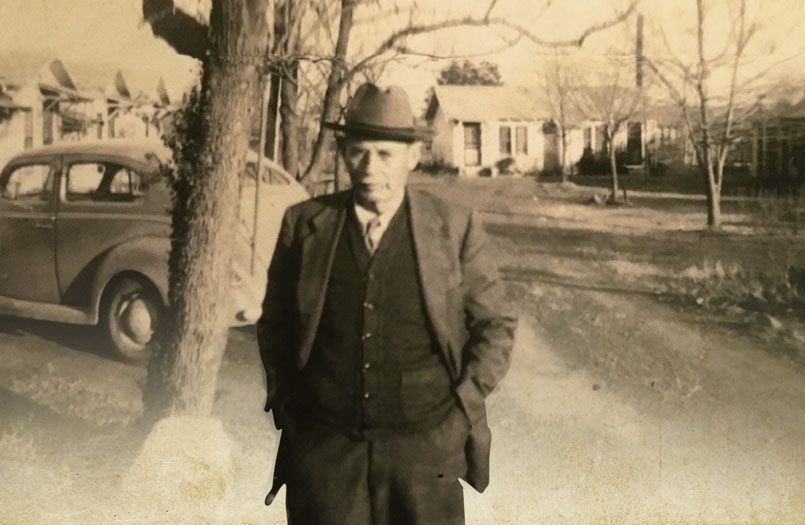02 Sep 2021 Gus Opitz: A Man Ahead of His Time
By Vivian Lawson Hogue
It took more than land and people to build the town that Conway founder Col. Asa Peter Robinson had in his always–forward–thinking mind. For a guy from Connecticut, he seemed to have a handle on the kind of people and entities needed for the town. So he built a school, a courthouse, a small “calaboose” (jail), a post office, and a train depot for what was then Conway Station, and all was done with his own funds.
The town became incorporated with a name change to simply Conway in 1875, and its growth began in earnest. Robinson saw to it that there were businesses that served the real needs of the residents. For luxury items, there were always the mail–order catalogues, the 1872 versions of Amazon. Even lumber, nails, and hardware to build complete houses could be ordered to arrive by train, so Conway was becoming thoroughly modernized.

As one might guess, farming and farm–related businesses were the prevailing livelihoods of many citizens of Conway and Faulkner County. By 1880, there were nearly 1,770 farms in the county. Besides cattle raising, cotton was king here, too. That called for blacksmiths, wagon yards, feedlots, gins, farm animal auctions, and small cafes for out–of–towners. Home and clothing needs were supplied at a successful dry goods store built by Max Frauenthal in 1872 and sold to cousins Jo Frauenthal and Leo Schwarz in 1892.
Not all businesses were related to farming. A hand–drawn map by historian Robert L. Gatewood shows approximate locations of some of the small businesses in 1880. Besides physicians, lawyers, druggists, grocers, hoteliers, and owners of cotton gins, there were those who sold their own creations or services, such as carpenters, tinsmiths, cabinet makers, jewelers, printers, and saddlers.
One of the needed businesses at the time was lumber production, and one company was operated by Mr. Johann Gustav Opitz. While lumber was an obvious need then, he also produced wooden barrel staves. His great–grandson, Conway resident Johnny Opitz, related to me his knowledge of this enterprising man.
“What I know about my great–grandfather, I know because of my father, my cousin Frank and the late Ed McMoran,” Johnny said. “Ed worked for Gus as a youngster, actually riding the log carriage that held the log as it passed into the blade. Gus would stand at the front facing the end of the log and would tilt his head either left or right to indicate which way Ed should roll the log on the next pass.”
For many generations, Johnny’s ancestors in Germany were wheelwrights, or makers of wheels, so wood seemed to be destined to be in Gus’s life.
Johnny added, “Gus was born in Marsdorf, Saxon, Germany, in 1867 and immigrated to Arkansas in 1882 at the age of 15.” The family of several children settled at Germania (Saline County), which was later renamed Vimy Ridge for the first Allied victory of World War I in Vimy Ridge, France. “While living there, the family wouldn’t light lamps at night for fear of neighbors shooting at them through the windows,” Johnny said. “Neither my grandfather nor his brother were taught any German words due to the danger posed in being German.
“Gus married Isabelle Beaty in 1890, and that same year he opened a sawmill in Haskell (Saline County) and expanded with a mill at Conway. They lived on the road that still bears his name. He also operated a cotton gin and a general store and even had his own railroad spur. He was known for employing more people than he needed just to provide jobs to folks in hard times.”
Johnny continued, “Gus, along with his sons and their wives, moved to Conway to exploit the virgin timber here and start some businesses. He harvested much of the virgin timber here in Conway and all of the Palarm bottoms south of Mayflower. This supplied most of Conway’s timber building needs.
“Sometime in the early 1900s, he had boarded a train on a whim and traveled out west, where he saw tourist courts for the first time. He later built a tourist court in Conway called Conway Cabins for his eldest son, Otis John. He also built a service station called Motor Service Station for the younger son, H.G. (Buck). Both businesses were on the same property as Gus’s sawmill/stavemill.”
Belle died in 1932, and Gus closed the mill at Haskell and moved to Conway.
After Gus died in 1943, Buck and Otis continued building and operating motels. Johnny adds, “Across the street on the west side of Washington Avenue at the Hunter Street intersection, the Bowen’s Tourist Court was built for my great–uncle, Clyde. Yet another one was constructed on the south end of town around the same time Gus’s sister built the Ideal Motel in 1945 on the new bypass.”
It seems if Gus was looking for businesses with plenty of demand and one with little or no competition. It is safe to say his entrepreneurial spirit found them.
John David (Johnny) Opitz is the son of the late John Henry and Eleanor Hardin Opitz. He stated that for generations all his paternal family’s first-born males were traditionally named “Johann,” “John,” or “Hans.”
- And that’s what Christmas is really all about - December 2, 2025
- Giving thanks - November 4, 2025
- Giving up was not an option - September 30, 2025








